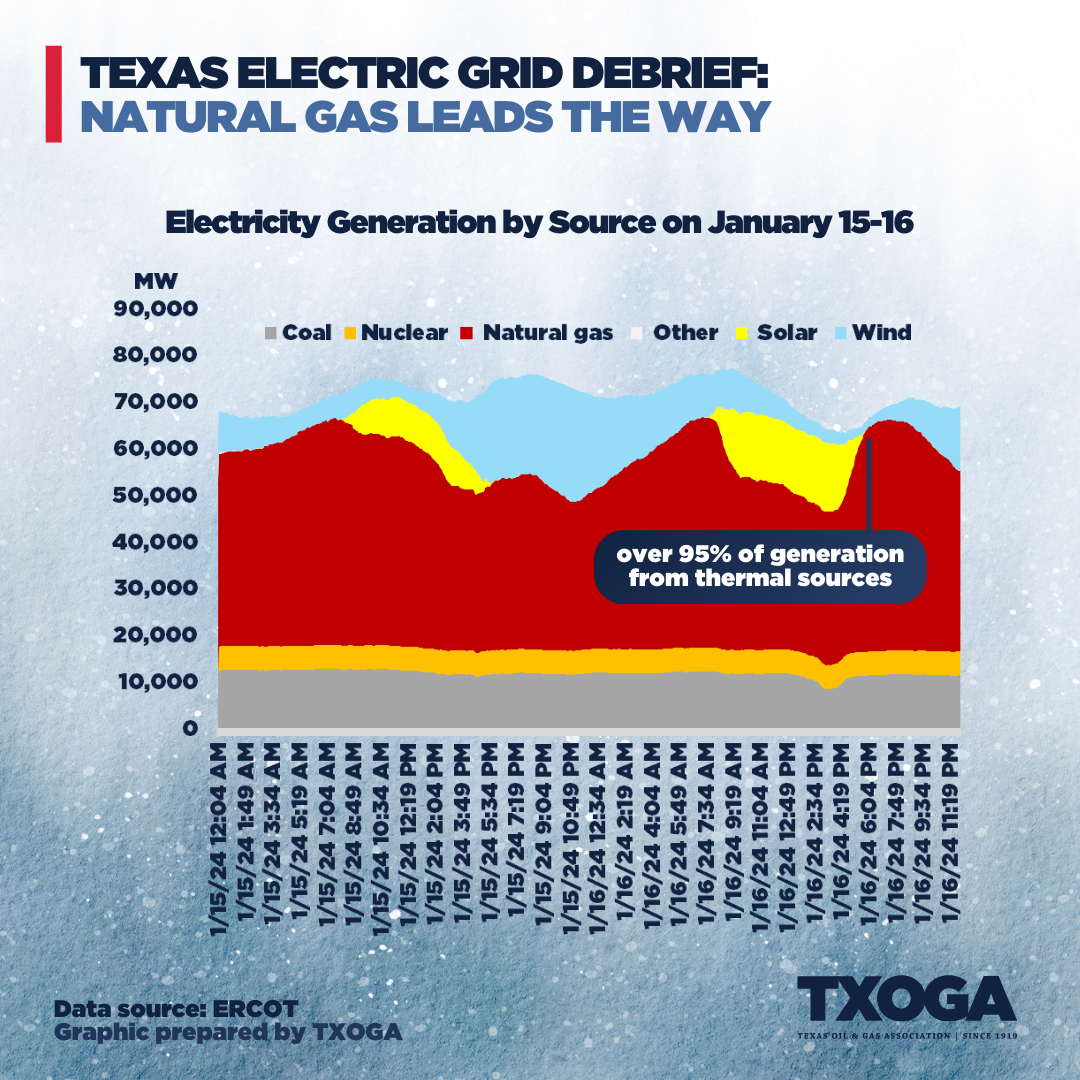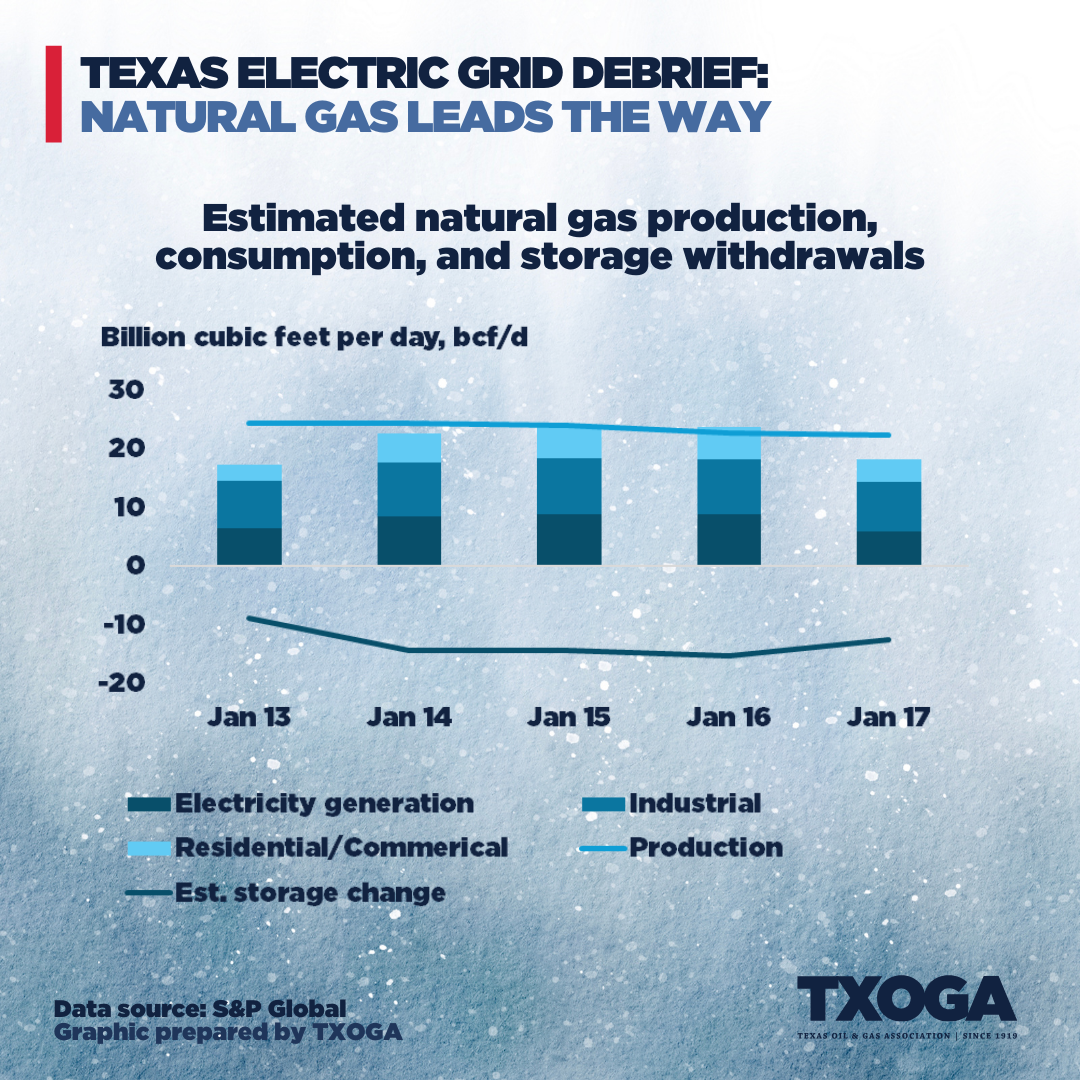AUSTIN – Texans faced brutally cold weather from Winter Storm Heather, which brought prolonged sub-freezing temperatures across the state as well as wintery precipitation. These adverse conditions placed a significant increase in demand on the state’s electric grid. Winter Storm Heather was the third coldest storm experienced by Texas in recent years behind Winter Storm Elliot in December 2022 and Winter Storm Uri in February 2021.
“Congratulations to the men and women who fought through harsh conditions to keep Texans warm. This test on our electric grid means the reforms enacted by the Legislature yielded positive results,” said Texas Oil & Gas Association (TXOGA) President Todd Staples. “As electricity demand continues to grow, we look forward to working with the Public Utility Commission of Texas (PUC) as they seek to balance the need for more dispatchable generation with growing intermittent resources, and battery storage. Continual refinement of the needed generation mix and forecasting tools will assist in meeting Texas’ future power needs and benefit consumers with affordable and reliable electricity.”

Together, all thermal sources including natural gas accounted for nearly 95% of electricity on the grid during the peak demand period, with weather-dependent sources providing 3% and battery storage 1%. While natural gas producers do not put electricity on the grid, natural gas-based generation was able to respond well because of strong performances by the natural gas production, pipeline, and storage systems.

Statutory changes required by the Texas Legislature and Governor Abbott since Winter Storm Uri proved impactful and the Electric Reliability Council of Texas (ERCOT) grid performed. Required weatherization of power generation facilities, ensuring power was prioritized for oil and natural gas field operations, ancillary services, and enhanced communication between the Texas Division of Emergency Management (TDEM), PUC, ERCOT and the Railroad Commission of Texas (RRC) all resulted in Texans remaining warm in their homes.
“Under extreme winter conditions, it’s clear that not all energy sources are created equal. Texas weathered Winter Storm Heather, thanks largely to the integral role that natural gas has played in ERCOT’s dispatchable thermal generation,” said TXOGA Chief Economist Dean Foreman. “Texas’ world-leading natural gas supply chain has continued to pay dividends, as preliminary data show record-high natural gas deliveries from storage on Monday and Tuesday, which simultaneously enabled robust electricity generation, residential and commercial heating, industrial production, and exports.”

During the storm, natural gas-based electricity generation consistently fueled 50% to 60% of load across the ERCOT region during three successive new record peaks in demand from Sunday, January 14 through Tuesday, January 16. On Sunday, January 14, ERCOT reported a new all-time weekend winter peak of 70,982 megawatts (MW), followed by a new all-time weekday winter peak on Monday, January 15 of 75,559 MW. On Tuesday, January 16, the record set the day before was broken with a new all-time weekday winter peak demand of 78,138 MW. The previous weekday winter peak demand record was 74,525 MW, set on Friday, December 23, 2022 during Winter Storm Elliot.
TEXAS FIELD CONDITIONS
Overall, field conditions were stable across the state, even with the cold temperatures. Personnel responded to issues that arose without significant impediments. Production and operations were within the anticipated ranges. A few isolated impacts to operators occurred across the natural gas supply chain such as power outages, third-party take away issues, and some road issues in East Texas, but were minor to overall systems and were quickly resolved. Transportation pressure was reported as stable, and storage and supply were readily available to meet requirements.
NATURAL GAS PRODUCTION, TRANSPORTATION AND STORAGE
Texas’ natural gas production, processing, transmission, and storage sectors continued to have needed production and storage. Overall, production declined slightly over the course of the front, as was expected with colder weather.
Localized issues, including compression outages, suspension of water hauling, and instrument performance were reported, but personnel were quickly able to resolve these issues. Overall, there was minimal impact to the state’s natural gas production and distribution system.
Transmission and distribution systems experienced stable pressures and received needed products even with anticipated reductions in production. Transmission from storage and line packing performed well. Preparedness and response protocols were implemented to respond to and restore operations as needed.
Natural gas-based generation was able to respond well because of strong performances by the natural gas pipeline and storage systems. Texas withdrew and delivered over 11 billion cubic feet per day (bcf/d) of natural gas on Monday, January 15 and Tuesday, January 16, contributing to record performance by nationwide natural gas storage per S&P Global.

OTHER PARTS OF COUNTRY IMPACTED
Certain conditions can adversely impact natural gas production. For example, a news report found that North Dakota’s oil production declined by about 50% as a result of the storm. Even North Dakota producers, known to regularly face disruptive temperatures and weather systems and who are some of the best prepared in the United States, went offline or experienced production declines. This underscores that those who need natural gas during projected inclement weather should take care to pre-contract and pre-plan for supply, storage and transmission before the storm. While producers go to great lengths to continue production, history teaches us impacts can occur under certain circumstances, and precautions for those that use natural gas are recommended.
NATURAL GAS PRICES REMAINED STEADY FOR TEXAS CONSUMERS
Thanks to robust natural gas infrastructure, including dominant upstream production in the field and the nation’s most extensive pipeline and storage network, consumers in Texas paid among the lowest natural gas prices across the nation during Winter Storm Heather.
Natural gas is traded at delivery points, based on specific timing and conditions across the pipeline network. As a result, the weather as well as broader market conditions can influence prices. During the storm, natural gas prices across the country — from New York to Chicago to the Pacific Northwest – ranged from $3 to $13 per million British Thermal Units (mmBtu) higher than Henry Hub, per data from S&P Global. This means that Texans have continued to experience greater economic and energy security compared with the rest of the country.
Industrial consumers who contracted for firm natural gas supply, delivery and prices prior to the cold front largely avoided price fluctuations. Over its final month of trading in December 2023, the natural gas futures contract for January 2024 delivery averaged $2.57 per mmBtu.
With a vast market and extensive connectivity across Texas, buyers have multifaceted options and are encouraged to take advantage of them. Although seasonal commodity price variation is typical, it can be mitigated through prudent planning.
KEY FINDINGS
In conclusion, the Texas electric grid remained resilient amid Winter Storm Heather, and experienced only minor, localized outages reported across the state. Localized issues with natural gas production and transportation were experienced, as expected during extreme cold weather, but issues were quickly resolved. Natural gas storage was utilized as needed and customers who contracted for firm natural gas supply, delivery and prices largely avoided price fluctuations, even while other parts of the country saw higher prices.
While Texas’ electric grid set new winter demand records, the grid’s resiliency was largely due to natural gas-based power generation, which served as the grid’s backbone of strong performances by the natural gas pipeline and storage systems. Despite increased demand, the Texas electric grid remained resilient, with only minor, localized outages reported across the state.
During the storm, TXOGA issued a series of Winter Weather Situation Reports which can be viewed here.
For more information on how the Texas oil and natural gas industry prepares months in advance of winter weather, visit here and here.
+++
Founded in 1919, TXOGA is the oldest and largest oil and gas trade association in Texas representing every facet of the industry.

